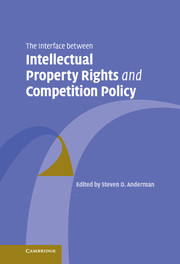Book contents
- Frontmatter
- Contents
- Notes on contributors
- Preface
- 1 The competition law/IP ‘interface’: an introductory note
- PART I Intellectual property rights and competition law in the major trading blocks
- PART II Intellectual property rights and competition law in smaller and medium sized open economies
- 5 Intellectual property rights and competition in Australia
- 6 Irish competition law and IP rights
- 7 The interface between intellectual property law and competition law in Singapore
- PART III Issues related to the interface between intellectual property rights and competition law
- Index
7 - The interface between intellectual property law and competition law in Singapore
Published online by Cambridge University Press: 27 July 2009
- Frontmatter
- Contents
- Notes on contributors
- Preface
- 1 The competition law/IP ‘interface’: an introductory note
- PART I Intellectual property rights and competition law in the major trading blocks
- PART II Intellectual property rights and competition law in smaller and medium sized open economies
- 5 Intellectual property rights and competition in Australia
- 6 Irish competition law and IP rights
- 7 The interface between intellectual property law and competition law in Singapore
- PART III Issues related to the interface between intellectual property rights and competition law
- Index
Summary
Overview: IP and competition laws within the Singapore legal framework
As a former British colony, Singapore's legal framework has been modelled closely after the common law and statutory instruments of the United Kingdom. The three primary intellectual property statutes in Singapore – concerned with copyright, patents and trade marks – bear a close resemblance to the corresponding UK statutes and their predecessors. Similarly, Singapore's recently-introduced competition law regime is based substantially on equivalent legislation from the UK which was, in turn, a codification of the European Community's competition law framework.
Despite the strong influence of UK laws on the domestic legislative framework which Singapore has enacted, a number of substantive modifications have been made by the legislature to further specific policy objectives which reflect domestic commercial and socio-economic conditions. Singapore has a small domestic market of less than 4 million consumers, but a relatively large, open and export-oriented economy. This chapter will highlight and discuss the various features of the Singapore legal framework which mediate between the frequently opposing goals of intellectual property law and competition law. Both these areas of law have evolved through, and continue to exist in, a state of flux as a result of Singapore's commitment to implement various international conventions and, more recently, to achieve compliance with its obligations under various free-trade agreements. Readers should therefore expect subsequent additions or changes to these two areas of law to continue beyond the publication date of this work.
- Type
- Chapter
- Information
- Publisher: Cambridge University PressPrint publication year: 2007



